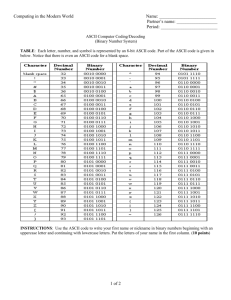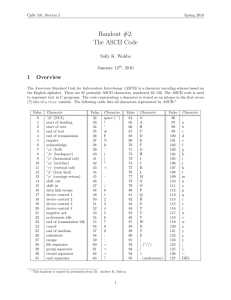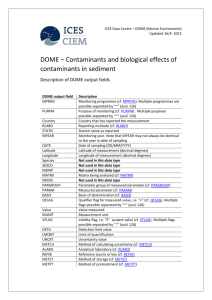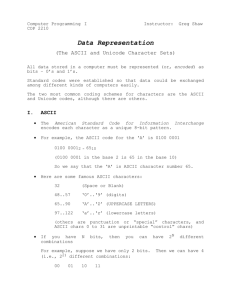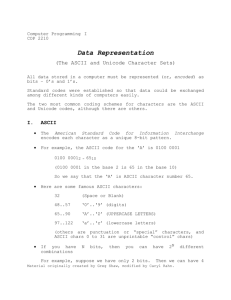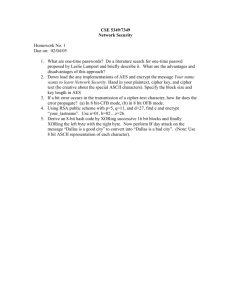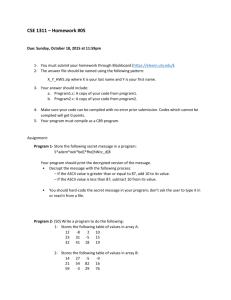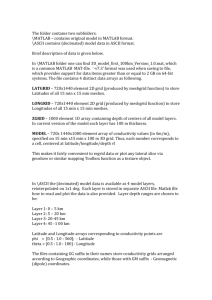ascii
advertisement
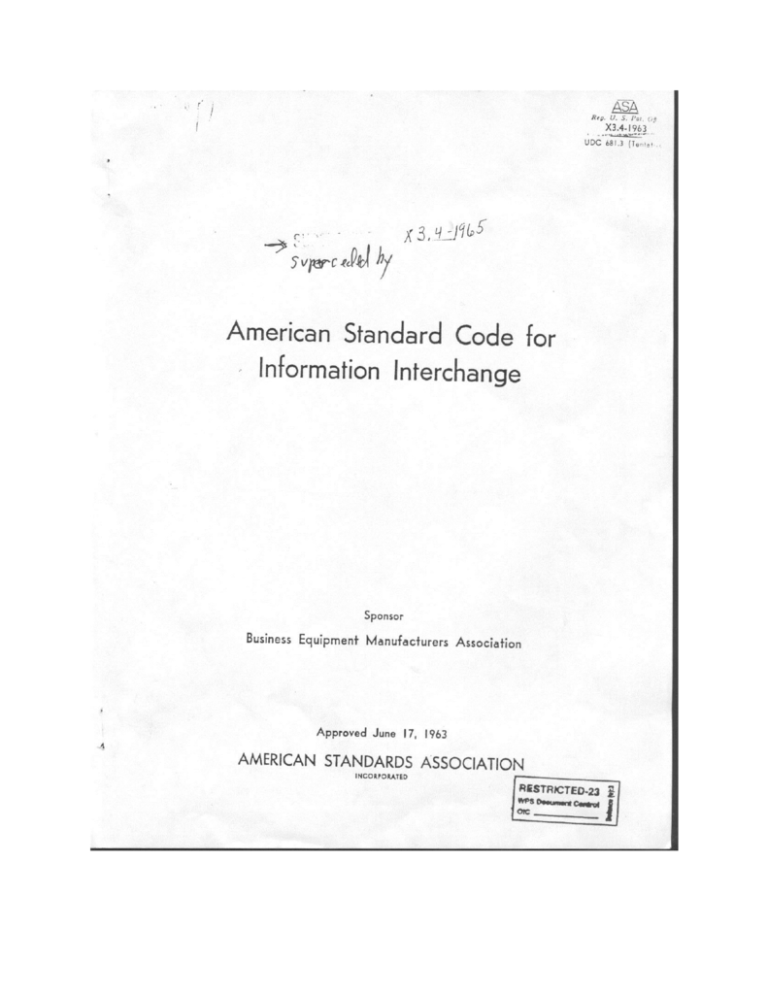
ASCII
1
ASCII
The American Standard Code for
Information Interchange (ASCII
/ˈæski/
ASS-kee)
is
a
character-encoding scheme originally
based on the English alphabet that
encodes 128 specified characters - the
numbers 0-9, the letters a-z and A-Z,
some basic punctuation symbols, some
control codes that originated with
Teletype machines, and a blank space into the 7-bit binary integers.[1]
ASCII codes represent text in
computers,
communications
equipment, and other devices that use
text. Most modern character-encoding
schemes are based on ASCII, though
they support many additional characters.
A chart of ASCII from a 1972 printer manual
ASCII developed from telegraphic codes. Its first commercial use was as a seven-bit teleprinter code promoted by
Bell data services. Work on the ASCII standard began on October 6, 1960, with the first meeting of the American
Standards Association's (ASA) X3.2 subcommittee. The first edition of the standard was published during 1963, a
major revision during 1967, and the most recent update during 1986. Compared to earlier telegraph codes, the
proposed Bell code and ASCII were both ordered for more convenient sorting (i.e., alphabetization) of lists, and
added features for devices other than teleprinters.
ASCII includes definitions for 128 characters: 33 are non-printing control characters (many now obsolete) that affect
how text and space are processed[2] and 95 printable characters, including the space (which is considered an invisible
graphic[3][4]).
The IANA prefers the name US-ASCII to avoid ambiguity. ASCII was the most commonly used character encoding
on the World Wide Web until December 2007, when it was surpassed by UTF-8, which includes ASCII as a subset.
History
The American Standard Code for Information Interchange (ASCII) was developed under the auspices of a committee
of the American Standards Association, called the X3 committee, by its X3.2 (later X3L2) subcommittee, and later
by that subcommittee's X3.2.4 working group. The ASA became the United States of America Standards Institute or
USASI[5] and ultimately the American National Standards Institute.
The X3.2 subcommittee designed ASCII based on the earlier teleprinter encoding systems. Like other character
encodings, ASCII specifies a correspondence between digital bit patterns and character symbols (i.e. graphemes and
control characters). This allows digital devices to communicate with each other and to process, store, and
communicate character-oriented information such as written language. Before ASCII was developed, the encodings
in use included 26 alphabetic characters, 10 numerical digits, and from 11 to 25 special graphic symbols. To include
all these, and control characters compatible with the Comité Consultatif International Téléphonique et Télégraphique
(CCITT) International Telegraph Alphabet No. 2 (ITA2) standard, Fieldata, and early EBCDIC, more than 64 codes
were required for ASCII.
ASCII
The committee debated the possibility of a shift key function (like the Baudot code), which would allow more than
64 codes to be represented by six bits. In a shifted code, some character codes determine choices between options for
the following character codes. It allows compact encoding, but is less reliable for data transmission; an error in
transmitting the shift code typically makes a long part of the transmission unreadable. The standards committee
decided against shifting, and so ASCII required at least a seven-bit code.[6]
The committee considered an eight-bit code, since eight bits (octets) would allow two four-bit patterns to efficiently
encode two digits with binary coded decimal. However, it would require all data transmission to send eight bits when
seven could suffice. The committee voted to use a seven-bit code to minimize costs associated with data
transmission. Since perforated tape at the time could record eight bits in one position, it also allowed for a parity bit
for error checking if desired.[7] Eight-bit machines (with octets as the native data type) that did not use parity
checking typically set the eighth bit to 0.
The code itself was patterned so that most control codes were together, and all graphic codes were together, for ease
of identification. The first two columns (32 positions) were reserved for control characters.[8]} The "space" character
had to come before graphics to make sorting easier, so it became position 20hex;[9] for the same reason, many special
signs commonly used as separators were placed before digits. The committee decided it was important to support
upper case 64-character alphabets, and chose to pattern ASCII so it could be reduced easily to a usable 64-character
set of graphic codes.[10] Lower case letters were therefore not interleaved with upper case. To keep options available
for lower case letters and other graphics, the special and numeric codes were arranged before the letters, and the
letter "A" was placed in position 41hex to match the draft of the corresponding British standard.[11] The digits 0–9
were arranged so they correspond to values in binary prefixed with 011, making conversion with binary-coded
decimal straightforward.
Many of the non-alphanumeric characters were positioned to correspond to their shifted position on typewriters.
Thus #, $ and % were placed to correspond to 3, 4, and 5 in the adjacent column. The parentheses could not
correspond to 9 and 0, however, because the place corresponding to 0 was taken by the space character. Since many
European typewriters placed the parentheses with 8 and 9, those corresponding positions were chosen for the
parentheses. The @ symbol was not used in continental Europe and the committee expected it would be replaced by
an accented À in the French variation, so the @ was placed in position 40hex next to the letter A.[12]
The control codes felt essential for data transmission were the start of message (SOM), end of address (EOA), end of
message (EOM), end of transmission (EOT), "who are you?" (WRU), "are you?" (RU), a reserved device control
(DC0), synchronous idle (SYNC), and acknowledge (ACK). These were positioned to maximize the Hamming
distance between their bit patterns.[13]
With the other special characters and control codes filled in, ASCII was published as ASA X3.4-1963, leaving 28
code positions without any assigned meaning, reserved for future standardization, and one unassigned control
code.[14] There was some debate at the time whether there should be more control characters rather than the lower
case alphabet.[15] The indecision did not last long: during May 1963 the CCITT Working Party on the New
Telegraph Alphabet proposed to assign lower case characters to columns 6 and 7,[16] and International Organization
for Standardization TC 97 SC 2 voted during October to incorporate the change into its draft standard.[17] The X3.2.4
task group voted its approval for the change to ASCII at its May 1963 meeting.[18] Locating the lowercase letters in
columns 6 and 7 caused the characters to differ in bit pattern from the upper case by a single bit, which simplified
case-insensitive character matching and the construction of keyboards and printers.
The X3 committee made other changes, including other new characters (the brace and vertical line characters),[19]
renaming some control characters (SOM became start of header (SOH)) and moving or removing others (RU was
removed).[20] ASCII was subsequently updated as USASI X3.4-1967, then USASI X3.4-1968, ANSI X3.4-1977,
and finally, ANSI X3.4-1986 (the first two are occasionally retronamed ANSI X3.4-1967, and ANSI X3.4-1968).
The X3 committee also addressed how ASCII should be transmitted (least significant bit first), and how it should be
recorded on perforated tape. They proposed a 9-track standard for magnetic tape, and attempted to deal with some
2
ASCII
3
forms of punched card formats.
ASCII itself was first used commercially during 1963 as a seven-bit teleprinter code for American Telephone &
Telegraph's TWX (TeletypeWriter eXchange) network. TWX originally used the earlier five-bit Baudot code, which
was also used by the competing Telex teleprinter system. Bob Bemer introduced features such as the escape
sequence. His British colleague Hugh McGregor Ross helped to popularize this work—according to Bemer, "so
much so that the code that was to become ASCII was first called the Bemer-Ross Code in Europe".[21] Because of
his extensive work on ASCII, Bemer has been called "the father of ASCII."
On March 11, 1968, U.S. President Lyndon B. Johnson mandated that all computers purchased by the United States
federal government support ASCII, stating:
I have also approved recommendations of the Secretary of Commerce regarding standards for recording
the Standard Code for Information Interchange on magnetic tapes and paper tapes when they are used in
computer operations. All computers and related equipment configurations brought into the Federal
Government inventory on and after July 1, 1969, must have the capability to use the Standard Code for
Information Interchange and the formats prescribed by the magnetic tape and paper tape standards when
these media are used.[22]
Other international standards bodies have ratified character encodings such as ISO/IEC 646 that are identical or
nearly identical to ASCII, with extensions for characters outside the English alphabet and symbols used outside the
United States, such as the symbol for the United Kingdom's pound sterling (£). Almost every country needed an
adapted version of ASCII, since ASCII suited the needs of only the USA and a few other countries. For example,
Canada had its own version that supported French characters. Other adapted encodings include ISCII (India), VISCII
(Vietnam), and YUSCII (Yugoslavia). Although these encodings are sometimes referred to as ASCII, true ASCII is
defined strictly only by the ANSI standard.
ASCII was incorporated into the Unicode character set as the first 128 symbols, so the ASCII characters have the
same numeric codes in both sets. This allows UTF-8 to be backward compatible with ASCII, allowing software that
handles UTF-8 data to treat ASCII data as UTF-8 data, and software made for ASCII treat UTF-8 data as ASCII
data, rather than distinguishing between ASCII and UTF-8.
ASCII control characters
ASCII reserves the first 32 codes (numbers 0–31 decimal) for control characters: codes originally intended not to
represent printable information, but rather to control devices (such as printers) that make use of ASCII, or to provide
meta-information about data streams such as those stored on magnetic tape. For example, character 10 represents the
"line feed" function (which causes a printer to advance its paper), and character 8 represents "backspace". RFC 2822
refers to control characters that do not include carriage return, line feed or white space as non-whitespace control
characters.[23] Except for the control characters that prescribe elementary line-oriented formatting, ASCII does not
define any mechanism for describing the structure or appearance of text within a document. Other schemes, such as
markup languages, address page and document layout and formatting.
The original ASCII standard used only short descriptive phrases for each control character. The ambiguity this
caused was sometimes intentional, for example where a character would be used slightly differently on a terminal
link than on a data stream, and sometimes accidental, for example with the meaning of "delete".
Probably the most influential single device on the interpretation of these characters was the Teletype Model 33 ASR,
which was a printing terminal with an available paper tape reader/punch option. Paper tape was a very popular
medium for long-term program storage until the 1980s, less costly and in some ways less fragile than magnetic tape.
In particular, the Teletype Model 33 machine assignments for codes 17 (Control-Q, DC1, also known as XON), 19
(Control-S, DC3, also known as XOFF), and 127 (Delete) became de facto standards. Because the keytop for the O
key also showed a left-arrow symbol (from ASCII-1963, which had this character instead of underscore), a
ASCII
noncompliant use of code 15 (Control-O, Shift In) interpreted as "delete previous character" was also adopted by
many early timesharing systems but eventually became neglected.
The use of Control-S (XOFF, an abbreviation for transmit off) as a "handshaking" signal warning a sender to stop
transmission because of impending overflow, and Control-Q (XON, "transmit on") to resume sending, persists to this
day in many systems as a manual output control technique. On some systems Control-S retains its meaning but
Control-Q is replaced by a second Control-S to resume output.
Code 127 is officially named "delete" but the Teletype label was "rubout". Since the original standard did not give
detailed interpretation for most control codes, interpretations of this code varied. The original Teletype meaning, and
the intent of the standard, was to make it an ignored character, the same as NUL (all zeroes). This was useful
specifically for paper tape, because punching the all-ones bit pattern on top of an existing mark would obliterate it.
Tapes designed to be "hand edited" could even be produced with spaces of extra NULs (blank tape) so that a block
of characters could be "rubbed out" and then replacements put into the empty space.
As video terminals began to replace printing ones, the value of the "rubout" character was lost. DEC systems, for
example, interpreted "Delete" to mean "remove the character before the cursor" and this interpretation also became
common in Unix systems. Most other systems used "Backspace" for that meaning and used "Delete" to mean
"remove the character at the cursor". That latter interpretation is the most common now.
Many more of the control codes have been given meanings quite different from their original ones. The "escape"
character (ESC, code 27), for example, was intended originally to allow sending other control characters as literals
instead of invoking their meaning. This is the same meaning of "escape" encountered in URL encodings, C language
strings, and other systems where certain characters have a reserved meaning. Over time this meaning has been
co-opted and has eventually been changed. In modern use, an ESC sent to the terminal usually indicates the start of a
command sequence, usually in the form of a so-called "ANSI escape code" (or, more properly, a "Control Sequence
Introducer") beginning with ESC followed by a "[" (left-bracket) character. An ESC sent from the terminal is most
often used as an out-of-band character used to terminate an operation, as in the TECO and vi text editors. In
graphical user interface (GUI) and windowing systems, ESC generally causes an application to abort its current
operation or to exit (terminate) altogether.
The inherent ambiguity of many control characters, combined with their historical usage, created problems when
transferring "plain text" files between systems. The best example of this is the newline problem on various operating
systems. Teletype machines required that a line of text be terminated with both "Carriage Return" (which moves the
printhead to the beginning of the line) and "Line Feed" (which advances the paper one line without moving the
printhead). The name "Carriage Return" comes from the fact that on a manual typewriter the carriage holding the
paper moved while the position where the keys struck the ribbon remained stationary. The entire carriage had to be
pushed (returned) to the right in order to position the left margin of the paper for the next line.
DEC operating systems (OS/8, RT-11, RSX-11, RSTS, TOPS-10, etc.) used both characters to mark the end of a line
so that the console device (originally Teletype machines) would work. By the time so-called "glass TTYs" (later
called CRTs or terminals) came along, the convention was so well established that backward compatibility
necessitated continuing the convention. When Gary Kildall cloned RT-11 to create CP/M he followed established
DEC convention. Until the introduction of PC DOS in 1981, IBM had no hand in this because their 1970s operating
systems used EBCDIC instead of ASCII and they were oriented toward punch-card input and line printer output on
which the concept of "carriage return" was meaningless. IBM's PC DOS (also marketed as MS-DOS by Microsoft)
inherited the convention by virtue of being a clone of CP/M, and Windows inherited it from MS-DOS.
Unfortunately, requiring two characters to mark the end of a line introduces unnecessary complexity and questions as
to how to interpret each character when encountered alone. To simplify matters plain text data streams, including
files, on Multics used line feed (LF) alone as a line terminator. Unix and Unix-like systems, and Amiga systems,
adopted this convention from Multics. The original Macintosh OS, Apple DOS, and ProDOS, on the other hand,
used carriage return (CR) alone as a line terminator; however, since Apple replaced it with the Unix-based OS X
4
ASCII
5
operating system, they now use line feed (LF) as well.
Computers attached to the ARPANET included machines running operating systems such as TOPS-10 and TENEX
using CR-LF line endings, machines running operating systems such as Multics using LF line endings, and machines
running operating systems such as OS/360 that represented lines as a character count followed by the characters of
the line and that used EBCDIC rather than ASCII. The Telnet protocol defined an ASCII "Network Virtual
Terminal" (NVT), so that connections between hosts with different line-ending conventions and character sets could
be supported by transmitting a standard text format over the network; it used ASCII, along with CR-LF line endings,
and software using other conventions would translate between the local conventions and the NVT. The File Transfer
Protocol adopted the Telnet protocol, including use of the Network Virtual Terminal, for use when transmitting
commands and transferring data in the default ASCII mode. This adds complexity to implementations of those
protocols, and to other network protocols, such as those used for E-mail and the World Wide Web, on systems not
using the NVT's CR-LF line-ending convention.[24]
Older operating systems such as TOPS-10, along with CP/M, tracked file length only in units of disk blocks and used
Control-Z (SUB) to mark the end of the actual text in the file. For this reason, EOF, or end-of-file, was used
colloquially and conventionally as a three-letter acronym (TLA) for Control-Z instead of SUBstitute. For a variety of
reasons, the end-of-text code, ETX aka Control-C, was inappropriate and using Z as the control code to end a file is
analogous to it ending the alphabet, a very convenient mnemonic aid. An historic common, and still prevalent,
convention uses the ETX aka Control-C code convention to interrupt and halt a program via an input data stream,
usually from a keyboard.
In C library and Unix conventions, the null character is used to terminate text strings; such null-terminated strings
can be known in abbreviation as ASCIZ or ASCIIZ, where here Z stands for "zero".
ASCII control code chart
Binary
Oct Dec Hex Abbr [25]
000 0000 000
0
00
NUL
000 0001 001
1
01
SOH
000 0010 002
2
02
STX
000 0011 003
3
03
ETX
000 0100 004
4
04
EOT
000 0101 005
5
05
ENQ
000 0110 006
6
06
ACK
000 0111 007
7
07
BEL
000 1000 010
8
08
BS
000 1001 011
9
09
HT
000 1010 012
10
0A
LF
000 1011 013
11
0B
VT
000 1100 014
12
0C
FF
000 1101 015
13
0D
CR
000 1110 016
14
0E
SO
␀
␁
␂
␃
␄
␅
␆
␇
␈
␉
␊
␋
␌
␍
␎
[26]
[27]
^@
\0
Name
Null character
^A
Start of Header
^B
Start of Text
^C
End of Text
^D
End of Transmission
^E
Enquiry
^F
Acknowledgment
^G
\a
Bell
^H
\b
Backspace
^I
\t
Horizontal Tab
^J
\n
Line feed
^K
\v
Vertical Tab
^L
\f
Form feed
^M
\r
Carriage return
^N
[28]
[29]
[30]
Shift Out
ASCII
6
000 1111 017
15
0F
SI
001 0000 020
16
10
DLE
001 0001 021
17
11
DC1
001 0010 022
18
12
DC2
001 0011 023
19
13
DC3
001 0100 024
20
14
DC4
001 0101 025
21
15
NAK
001 0110 026
22
16
SYN
001 0111 027
23
17
ETB
001 1000 030
24
18
CAN
001 1001 031
25
19
EM
001 1010 032
26
1A
SUB
001 1011 033
27
1B
ESC
001 1100 034
28
1C
FS
001 1101 035
29
1D
GS
001 1110 036
30
1E
RS
001 1111 037
31
1F
US
111 1111 177 127
7F
DEL
␏
␐
␑
␒
␓
␔
␕
␖
␗
␘
␙
␚
␛
␜
␝
␞
␟
␡
^O
Shift In
^P
Data Link Escape
^Q
Device Control 1 (oft. XON)
^R
Device Control 2
^S
Device Control 3 (oft. XOFF)
^T
Device Control 4
^U
Negative Acknowledgement
^V
Synchronous idle
^W
End of Transmission Block
^X
Cancel
^Y
End of Medium
^Z
Substitute
^[
[31]
\e
[32]
Escape
^\
File Separator
^]
Group Separator
[33]
^^
Record Separator
^_
Unit Separator
^?
Delete
[34][]
[1] RFC 4949
[2] International Organization for Standardization (December 1, 1975). " The set of control characters for ISO 646 (http:/ / www. itscj. ipsj. or.
jp/ ISO-IR/ 001. pdf)". Internet Assigned Numbers Authority Registry. Alternate U.S. version: (http:/ / www. itscj. ipsj. or. jp/ ISO-IR/ 006.
pdf). Accessed 2008-04-14.
[3] "RFC 20: ASCII format for Network Interchange" (http:/ / tools. ietf. org/ html/ rfc20), ANSI X3.4-1968, October 16, 1969.
[4] Mackenzie 1980, p. 223.
[5] Mackenzie 1980, p. 211.
[6] Mackenzie 1980, p. 215, Decision 4.
[7] Mackenzie 1980, p. 217, Decision 5.
[8] Mackenzie 1980, p. 220, Decisions 8,9.
[9] Mackenzie 1980, p. 237, Decision 10.
[10] Mackenzie 1980, p. 228, Decision 14.
[11] Mackenzie 1980, p. 238, Decision 18.
[12] Mackenzie 1980, p. 243.
[13] Mackenzie 1980, pp. 243-245.
[14] Mackenzie 1980, pp. 66, 245.
[15] Mackenzie 1980, p. 435.
[16] Brief Report: Meeting of CCITT Working Party on the New Telegraph Alphabet, May 13–15, 1963.
[17] Report of ISO/TC/97/SC 2 – Meeting of October 29–31, 1963.
[18] Report on Task Group X3.2.4, June 11, 1963, Pentagon Building, Washington, DC.
[19] Report of Meeting No. 8, Task Group X3.2.4, December 17 and 18, 1963
[20] Mackenzie 1980, p. 247–248.
[21] Bob Bemer (n.d.). Bemer meets Europe (http:/ / www. trailing-edge. com/ ~bobbemer/ EUROPE. HTM). Trailing-edge.com. Accessed
2008-04-14. Employed at IBM at that time
[22] Lyndon B. Johnson (March 11, 1968). Memorandum Approving the Adoption by the Federal Government of a Standard Code for
Information Interchange (http:/ / www. presidency. ucsb. edu/ ws/ index. php?pid=28724). The American Presidency Project. Accessed
ASCII
7
2008-04-14.
[23] RFC 2822 (April 2001). "NO-WS-CTL".
[24] EOL translation plan for Mercurial (http:/ / mercurial. selenic. com/ wiki/ EOLTranslationPlan)
[25] The Unicode characters from the area U+2400 to U+2421 reserved for representing control characters when it is necessary to print or
display them rather than have them perform their intended function. Some browsers may not display these properly.
[26] Caret notation often used to represent control characters on a terminal. On most text terminals, holding down the key while typing the
second character will type the control character. Sometimes the shift key is not needed, for instance ^@ may be typable with just Ctrl and 2.
[27] Character Escape Codes in C programming language and many other languages influenced by it, such as Java and Perl (though not all
implementations necessarily support all escape codes).
[28] The Backspace character can also be entered by pressing the key on some systems.
[29] The Tab character can also be entered by pressing the key on most systems.
[30] The Carriage Return character can also be entered by pressing the or key on most systems.
[31] The '\e' escape sequence is not part of ISO C and many other language specifications. However, it is understood by several compilers,
including GCC.
[32] The Escape character can also be entered by pressing the key on some systems.
[33] ^^ means (pressing the "Ctrl" and caret keys).
[34] The Delete character can sometimes be entered by pressing the key on some systems.
Other representations might be used by specialist equipment, for example ISO 2047 graphics or hexadecimal
numbers.
ASCII printable characters
Codes 20hex to 7Ehex, known as the printable characters, represent letters, digits, punctuation marks, and a few
miscellaneous symbols. There are 95 printable characters in total.
Code 20hex, the space character, denotes the space between words, as produced by the space-bar of a keyboard. Since
the space character is considered an invisible graphic (rather than a control character)[4] and thus would not normally
be visible, it is represented here by Unicode character U+2420 "␠"; Unicode characters U+2422 "␢" and U+2423 "␣"
are also available for use when a visible representation of a space is necessary.
Code 7Fhex corresponds to the non-printable "Delete" (DEL) control character and is therefore omitted from this
chart; it is covered in the previous section's chart.
Earlier versions of ASCII used the up-arrow instead of the caret (5Ehex) and the left-arrow instead of the underscore
(5Fhex).[1]
Character
List:
!"#$%&'()*+,-./0123456789:;<=>?@ABCDEFGHIJKLMNOPQRSTUVWXYZ[\]^_`abcdefghijklmnopqrstuvwxyz{|}~
Reverse
List:
~}|{zyxwvutsrqponmlkjihgfedcba`_^]\[ZYXWVUTSRQPONMLKJIHGFEDCBA@?>=<;:9876543210/.-,+*)('&%$#"!
Binary
Oct Dec Hex
Glyph
010 0000 040
32
20
space (punctuation)
010 0001 041
33
21
[[Exclamation mark ]]
010 0010 042
34
22
"
010 0011 043
35
23
#
010 0100 044
36
24
$
010 0101 045
37
25
%
010 0110 046
38
26
&
010 0111 047
39
27
'
010 1000 050
40
28
(
010 1001 051
41
29
)
ASCII
8
010 1010 052
42
2A
*
010 1011 053
43
2B
+
010 1100 054
44
2C
,
010 1101 055
45
2D
-
010 1110 056
46
2E
.
010 1111 057
47
2F
/
011 0000 060
48
30
0
011 0001 061
49
31
1
011 0010 062
50
32
2
011 0011 063
51
33
3
011 0100 064
52
34
4
011 0101 065
53
35
5
011 0110 066
54
36
6
011 0111 067
55
37
7
011 1000 070
56
38
8
011 1001 071
57
39
9
011 1010 072
58
3A
:
011 1011 073
59
3B
;
011 1100 074
60
3C
<
011 1101 075
61
3D
=
011 1110 076
62
3E
>
011 1111 077
63
3F
?
Binary
Oct Dec Hex Glyph
100 0000 100
64
40
@
100 0001 101
65
41
A
100 0010 102
66
42
B
100 0011 103
67
43
C
100 0100 104
68
44
D
100 0101 105
69
45
E
100 0110 106
70
46
F
100 0111 107
71
47
G
100 1000 110
72
48
H
100 1001 111
73
49
I
100 1010 112
74
4A
J
100 1011 113
75
4B
K
100 1100 114
76
4C
L
100 1101 115
77
4D
M
100 1110 116
78
4E
N
100 1111 117
79
4F
O
ASCII
9
101 0000 120
80
50
P
101 0001 121
81
51
Q
101 0010 122
82
52
R
101 0011 123
83
53
S
101 0100 124
84
54
T
101 0101 125
85
55
U
101 0110 126
86
56
V
101 0111 127
87
57
W
101 1000 130
88
58
X
101 1001 131
89
59
Y
101 1010 132
90
5A
Z
101 1011 133
91
5B
[
101 1100 134
92
5C
\
101 1101 135
93
5D
]
101 1110 136
94
5E
^
101 1111 137
95
5F
_
Binary
Oct Dec Hex Glyph
110 0000 140
96
60
`
110 0001 141
97
61
a
110 0010 142
98
62
b
110 0011 143
99
63
c
110 0100 144 100
64
d
110 0101 145 101
65
e
110 0110 146 102
66
f
110 0111 147 103
67
g
110 1000 150 104
68
h
110 1001 151 105
69
i
110 1010 152 106
6A
j
110 1011 153 107
6B
k
110 1100 154 108
6C
l
110 1101 155 109
6D
m
110 1110 156 110
6E
n
110 1111 157 111
6F
o
111 0000 160 112
70
p
111 0001 161 113
71
q
111 0010 162 114
72
r
111 0011 163 115
73
s
111 0100 164 116
74
t
111 0101 165 117
75
u
ASCII
10
111 0110 166 118
76
v
111 0111 167 119
77
w
111 1000 170 120
78
x
111 1001 171 121
79
y
111 1010 172 122
7A
z
111 1011 173 123
7B
{
111 1100 174 124
7C
|
111 1101 175 125
7D
}
111 1110 176 126
7E
~
Aliases
A June 1992 RFC[2] and the Internet Assigned Numbers Authority registry of character sets recognize the following
case-insensitive aliases for ASCII as suitable for use on the Internet:
•
•
•
•
•
ANSI_X3.4-1968 (canonical name)
iso-ir-6
ANSI_X3.4-1986
ISO_646.irv:1991
ASCII
•
•
•
•
•
•
• (with ASCII-7 and ASCII-8 variants)Wikipedia:Verifiability
ISO646-US
US-ASCII (preferred MIME name)[]
us
IBM367
cp367
csASCII
Of these, the IANA encourages use of the name "US-ASCII" for Internet uses of ASCII (even if it is a redundant
acronym, but the US is needed because of abuse of the ASCII term). One often finds this in the optional "charset"
parameter in the Content-Type header of some MIME messages, in the equivalent "meta" element of some HTML
documents, and in the encoding declaration part of the prologue of some XML documents.
Variants
As computer technology spread throughout the world, different standards bodies and corporations developed many
variations of ASCII to facilitate the expression of non-English languages that used Roman-based alphabets. One
could class some of these variations as "ASCII extensions", although some misuse that term to represent all variants,
including those that do not preserve ASCII's character-map in the 7-bit range.
The PETSCII code Commodore International used for their 8-bit systems is probably unique among post-1970 codes
in being based on ASCII-1963, instead of the more common ASCII-1967, such as found on the ZX Spectrum
computer. Atari 8-bit computers and Galaksija computers also used ASCII variants.
ASCII
11
7-bit
From early in its development,[3] ASCII was intended to be just one of several national variants of an international
character code standard, ultimately published as ISO/IEC 646 (1972), which would share most characters in common
but assign other locally useful characters to several code points reserved for "national use." However, the four years
that elapsed between the publication of ASCII-1963 and ISO's first acceptance of an international recommendation
during 1967[4] caused ASCII's choices for the national use characters to seem to be de facto standards for the world,
causing confusion and incompatibility once other countries did begin to make their own assignments to these code
points.
ISO/IEC 646, like ASCII, was a 7-bit character set. It did not make any additional codes available, so the same code
points encoded different characters in different countries. Escape codes were defined to indicate which national
variant applied to a piece of text, but they were rarely used, so it was often impossible to know what variant to work
with and therefore which character a code represented, and in general text-processing systems could cope with only
one variant anyway.
Because the bracket and brace characters of ASCII were assigned to "national use" code points that were used for
accented letters in other national variants of ISO/IEC 646, a German, French, or Swedish, etc. programmer using
their national variant of ISO/IEC 646, rather than ASCII, had to write, and thus read, something such as
ä aÄiÜ='Ön'; ü
instead of
{ a[i]='\n'; }
C trigraphs were created to solve this problem for ANSI C, although their late introduction and inconsistent
implementation in compilers limited their use.
8-bit
Eventually, as 8-, 16- and 32-bit (and later 64-bit) computers began to replace 18- and 36-bit computers as the norm,
it became common to use an 8-bit byte to store each character in memory, providing an opportunity for extended,
8-bit, relatives of ASCII. In most cases these developed as true extensions of ASCII, leaving the original
character-mapping intact, but adding additional character definitions after the first 128 (i.e., 7-bit) characters.
Most early home computer systems developed their own 8-bit character sets containing line-drawing and game
glyphs, and often filled in some or all of the control characters from 0-31 with more graphics. The IBM PC defined
code page 437, which replaced the control-characters with graphic symbols such as smiley faces, and mapped
additional graphic characters to the upper 128 positions. Operating systems such as DOS supported these
code-pages, and manufacturers of IBM PCs supported them in hardware. Digital Equipment Corporation developed
the Multinational Character Set (DEC-MCS) for use in the popular VT220 terminal, this was one of the first
extensions designed more for international languages than for block graphics. The Macintosh defined Mac OS
Roman and Postscript also defined a set, both of these contained both international letters and typographic
punctuation marks instead of graphics, more like modern character sets. The ISO/IEC 8859 standard (derived from
the DEC-MCS) finally provided a standard that most systems copied (at least as accurately as they copied ASCII, but
with many substitutions). A popular further extension designed by Microsoft, Windows-1252 (often mislabeled as
ISO-8859-1), added the typographic punctuation marks needed for attractive text printing.
ISO-8859-1, Windows-1252, and the original 7-bit ASCII were the most common character encodings until the late
2000s, nowadays UTF-8 is becoming more common.
ASCII
12
Unicode
Unicode and the ISO/IEC 10646 Universal Character Set (UCS) have a much wider array of characters, and their
various encoding forms have begun to supplant ISO/IEC 8859 and ASCII rapidly in many environments. While
ASCII is limited to 128 characters, Unicode and the UCS support more characters by separating the concepts of
unique identification (using natural numbers called code points) and encoding (to 8-, 16- or 32-bit binary formats,
called UTF-8, UTF-16 and UTF-32).
To allow backward compatibility, the 128 ASCII and 256 ISO-8859-1 (Latin 1) characters are assigned
Unicode/UCS code points that are the same as their codes in the earlier standards. Therefore, ASCII can be
considered a 7-bit encoding scheme for a very small subset of Unicode/UCS, and ASCII (when prefixed with 0 as
the eighth bit) is valid UTF-8.
Order
ASCII-code order is also called ASCIIbetical order. Collation of data is sometimes done in this order rather than
"standard" alphabetical order (collating sequence). The main deviations in ASCII order are:
• All uppercase come before lowercase letters, for example, "Z" before "a"
• Digits and many punctuation marks come before letters; for example, "4" precedes "one"
• Numbers are sorted naïvely as strings; for example, "10" precedes "2"
An intermediate order — readily implemented — converts uppercase letters to lowercase before comparing ASCII
values. Naïve number sorting can be averted by zero-filling all numbers (e.g. "02" will sort before "10" as expected),
although this is an external fix and has nothing to do with the ordering itself.
References
Footnotes
[1]
[2]
[3]
[4]
ASA X3.4-1963 (http:/ / www. wps. com/ projects/ codes/ X3. 4-1963/ index. html).
RFC 1345 (June 1992).
"Specific Criteria," attachment to memo from R. W. Reach, "X3-2 Meeting – September 14 and 15," September 18, 1961
R. Maréchal, ISO/TC 97 – Computers and Information Processing: Acceptance of Draft ISO Recommendation No. 1052, December 22, 1967
Bibliography
• Mackenzie, Charles E. (1980). Coded Character Sets, History and Development. Addison-Wesley.
ISBN 0-201-14460-3.
Further reading
• Bemer, R. W. (1960). "A Proposal for Character Code Compatibility". Communications of the ACM 3 (2): 71–72.
doi: 10.1145/366959.366961 (http://dx.doi.org/10.1145/366959.366961).
• Bemer, R. W (May 23, 2003). "The Babel of Codes Prior to ASCII: The 1960 Survey of Coded Character Sets:
The Reasons for ASCII" (http://www.trailing-edge.com/~bobbemer/SURVEY.HTM). from:
• Bemer, R. W. (December 1960), "Survey of coded character representation", Communications of the ACM 3
(12): 639–641, doi: 10.1145/367487.367493 (http://dx.doi.org/10.1145/367487.367493)
• Smith, H. J.; Williams, F. A. (December 1960), "Survey of punched card codes", Communications of the ACM
3 (12): 642, doi: 10.1145/367487.367491 (http://dx.doi.org/10.1145/367487.367491)
• Robinson, G. S. & Cargill, C. (1996). "History and impact of computer standards". Computer 29 (10): 79–85. doi:
10.1109/2.539725 (http://dx.doi.org/10.1109/2.539725).
• American National Standard Code for Information Interchange. American National Standards Institute. 1977.
ASCII
External links
• The ASCII subset (http://www.unicode.org/charts/PDF/U0000.pdf) of Unicode
• The Evolution of Character Codes, 1874–1968 (http://www.pobox.com/~enf/ascii/ascii.pdf)
• Scanned copy of American Standard Code for Information Interchange ASA standard X3.4-1963 (http://wps.
com/projects/codes/X3.4-1963/index.html)
13
Article Sources and Contributors
Article Sources and Contributors
ASCII Source: https://en.wikipedia.org/w/index.php?oldid=583162613 Contributors: 126pk, 24ip, 28bytes, 32X, 4twenty42o, 7Keypad, 9thbit, A. di M., A12n, A8UDI, ABCD, AMR, Abdull,
AdamRaizen, Addihockey10, Aditya, Adriatikus, AgentPeppermint, Ahoerstemeier, Alansohn, Aleksandar Šušnjar, Allstarecho, Amire80, Andrejj, Andyhowlett, Angela, Animum, Anomie,
AnonMoos, Apokrif, Arda Xi, Arjun G. Menon, Ashershow1, Asmeurer, Augietrautz, AxelBoldt, Axlrosen, AzaToth, B2382F29, B4hand, BCube, BD2412, BDE1982, BIL, Baa, Badon,
Barabuski, Basil.bourque, Bbx, Bender235, Benjamin Mako Hill, Bennytheboy, Betacommand, Bevo, Bgwhite, Bisqwit, Bitsecure, Bjmullan, Bobblewik, Bobo192, Bongwarrior, BonsaiViking,
Boujois, Brendan Moody, Brianski, Brighterorange, Brouhaha, Bryan Derksen, Bryant1410, CLW, CRGreathouse, CTZMSC3, Cadby Waydell Bainbrydge, Caffolote, Caltrop, Can't sleep, clown
will eat me, Cbdorsett, Cburnett, Cema, Ceyockey, Chaosrxn, Cherlin, Chris Chittleborough, Chris D Heath, Chris is me, ChrisGualtieri, ChrisTek, Christian List, Chrsclmn, Clappingsimon,
Cleared as filed, Closedmouth, Cobaltcigs, Codename Lisa, Codysnider, ColbertTOLDMETODOIT, Comp.arch, Computer97, Conversion script, Coroboy, Corti, Crimsunwulf, Curps, Cyanoa
Crylate, Cybercobra, CyborgTosser, DHN, DVD R W, David Gerard, DavidCary, Dbachmann, Dcanright, DeadEyeArrow, Deflective, Dendodge, DennisWithem, DerHexer, DexDor, Dfrankow,
Dfrg.msc, Diabolical mdog, Direvus, Discospinster, Dispenser, Dl2000, Dmeranda, Dmlandfair, DocWatson42, Domthedude001, Donaldgdavis, Donarreiskoffer, Doomdayx, Dragonscales,
Dreftymac, DropDeadGorgias, Drphilharmonic, Dwiakigle, Dysprosia, ERcheck, Ed g2s, Edward Z. Yang, Egil, Eigenlambda, Ekohlwey, El C, Electron9, Eleeeeeephan, Elektron, Ellers,
Elliskev, Elm-39, Eloquence, Elpollo, Elwikipedista, Emijrp, Emperorbma, Enf, Epbr123, Eric N Fischer, Eubulides, Eugenwpg, Evertype, Everyking, Extropian314, Eyreland, FFraenz, Fabartus,
Fastily, Favonian, Finell, Fish and karate, FrankGinzoFella, Freedomlinux, FreplySpang, Fresheneesz, Frungi, Fudoreaper, Fullstop, Furrykef, Fuzheado, Fæ, G1234, Gail, Gaius Cornelius,
Galwhaa, Gancheff, GatesPlusPlus, Gauss, Gazibara, Gene Thomas, Geo Swan, George The Dragon, GeorgeLouis, Gerbrant, Ghettoblaster, Giftlite, Gilliam, Gimboid13, Gimmetoo, Gimmetrow,
Giobe2000, Giulio.orru, Glaisher, Glloq, Gracenotes, GraemeL, Graham87, GreatWhiteNortherner, GreggTownsend, Gtg204y, Gutworth, Gutza, Guy Harris, Gwalla, Hadal, HairyWombat,
Hajhouse, Harland1, Herbee, Hevelius, HexaChord, Hhielscher, Hobart, Hotcrocodile, Hotlorp, Hu12, Hydrargyrum, I am One of Many, IAMDESU, IMSoP, Iamzemasterraf, Icairns, Icey,
Ignaciomella, Ike, Ilikepie00, Ilya, Indefatigable, Intgr, Iridescent, J Di, J.delanoy, JDBravo, JLaTondre, JMyrleFuller, Jagged 85, JakeVortex, Jallan, Jasonglchu, Java13690, Java7837, Jay,
Jbmurray, Jeandré du Toit, Jeanhaney, Jeff G., Jeffrey Henning, Jeffthejiff, Jengod, Jesdisciple, Jesseili, Jfioeawfjdls453, Jianhui67, Jjk, Jmajeremy, Johnteslade, Jonathan Drain,
Jonathanrcoxhead, Jordan Brown, Jsnx, KJRehberg, KTC, Kaisershatner, Kalidasa 777, Karl Dickman, Kbdank71, Kbolino, KeithTyler, Keka, Kerowyn, KerryVeenstra, Khazaei.mr, KillaDamo,
Kjoonlee, Kricxjo, Krótki, Kubanczyk, Kune, Kvng, Kwamikagami, Kwi, Kylegwot, LWChris, LarryGilbert, Latics, LeadSongDog, Lee Daniel Crocker, Lelkesa, LeoNomis, LeonardoRob0t,
Leuko, Levin, Lfwlfw, Lgfcd, Liftarn, Lincher, Ling.Nut, LittleOldMe old, Loadmaster, LodeRunner, Logan, Loohcsnuf, Lotje, LouDogg, Lowellian, LuNatic, Luna Santin, Lupin, Maclean25,
Magioladitis, MagnaMopus, Magnus Bakken, Mahmudmasri, Mange01, Manop, Mardus, Mark Rosenthal, MarkMLl, MarkOverton222, Martial75, Materialscientist, Matt Britt, MattGiuca,
Matthiaspaul, Maury Markowitz, Mav, Maxamegalon2000, Maximaximax, Mblumber, Mboverload, McSly, MeekMark, Mercury, Michael Frind, Michaeln, Mike Rosoft, Mike Schwartz, Mike
Selinker, Mikehead, Mikeisgay12345, Mild Bill Hiccup, Mindspillage, Minna Sora no Shita, Mitch Ames, Mjb, Mjec, Mkhadpe, Modulatum, Monedula, Mono .lck, Morgan Leigh,
Mothmolevna, Mpolo, Mpwrmnt, MrWeeble, MusikAnimal, Musiphil, Mwtoews, Myleslong, N5iln, NSR, Naelphin, Namazu-tron, Naohiro19, Nate Silva, Nathanaeljones, NatusRoma, Nestea
Zen, NevilleDNZ, Nick Comber, Nickj, Nikola Smolenski, Nohat, Noldoaran, Nonky, NotACow, Nwbeeson, ORBIT, Oblivious, Octane, Ohhzone, Ohnoitsjamie, OlEnglish, Oleg Alexandrov,
Oli Filth, Omegatron, Onegin1, Onorem, Orayzio, OrgasGirl, Ortolan88, Ost316, Owain, OwenBlacker, Oxymoron83, P0lyglut, PSUMark2006, Pabouk, Panser Born, Patrick, PatrickSauncy,
Patsw, Paul Magnussen, Paulschou, Pb30, Pboyd04, Pedant17, Pengo, Per Abrahamsen, Peripitus, PeterThoeny, Pgk, Phantomsteve, PhilHibbs, Phuzion, Pichai Asokan, Piet Delport, Pinethicket,
Plugwash, Pne, Poiuyuiop, Porterjoh, Potaco99, Potatoswatter, Prohlep, Psychonaut, Pxma, Python eggs, Quercus solaris, Quintote, R.123, RJaguar3, RTC, Raise exception, Ralos,
Raymondwinn, ReallyNiceGuy, Redquark, Reisio, Relaxing, RenesisX, RexNL, Rich Farmbrough, RickK, Rjwilmsi, Rob Hooft, Robbgodshaw, Robert Moyse, RobertG, RockMFR, Rocksissor,
Ron1947, Roomoor, Rts.bn.vs, Runlevel1, SMC, ST47, Sade, Saga City, Salix alba, SallyForth123, Salvio giuliano, SandyJax, SchfiftyThree, Scientus, Scovetta, Sean William, Seraphim, Sergent
Tooj, Shadowjams, Shanes, Shimonnyman, Shlomital, Shoeofdeath, Sintaku, SirEpicMan, SixSix, Sjoerd visscher, Skarebo, Sl, Slapmaster3000, Slightsmile, Smite-Meister, Snoyes, Soccerimp,
SpaceFlight89, Spearhead, Speck-Made, Spel-Punc-Gram, Spitzak, Squorky1, Stassats, Stephen, Stephenb, Stephenchou0722, StevenDH, Sunny256, Superm401, Susvolans, Swtpc6800,
T-bonham, Taka, TakuyaMurata, Tangotango, Tannin, Tbhotch, Tbutzon, Tbvdm, Tearsinraine, Tedius Zanarukando, Tempshill, Terr0rist333, The Epopt, The Mark of the Beast, The Rambling
Man, The Singing Badger, The Thing That Should Not Be, Thelibragirl, Thesean43, Thewayforward, Tide rolls, TigerShark, Tim Starling, Timwi, Titoxd, Tizio, Tobias Bergemann, Tompsci,
Traal, Transfinite, TreasuryTag, Treekids, Tripodics, Twas Now, Tyler, UU, Ultraexactzz, UnknownzD, Uriber, UserGoogol, Vadmium, Valery Beaud, VampWillow, Vanisaac, Vanished user
9i39j3, Vary, Vegpuff, VictorLucas, Vishahu, VishantG, Wa3frp, WaltBusterkeys, Wardog, Wario456, Wavelength, Wayward, Wereon, Werieth, Wernher, Widr, WikiWikiHacker, Wikiklrsc,
William Avery, Wimt, Winterst, Wizardman, WorldlyWebster, WormNut, Wtshymanski, Ww, Xaosflux, Xevious, Yacht, Yaksar, Yintan, Yosri, ZX81, ZapThunderstrike, Zenohockey, ZeroEgo,
Zoezoo, Zundark, Zzuuzz, Саша Стефановић, 909 anonymous edits
Image Sources, Licenses and Contributors
File:ASCII Code Chart-Quick ref card.jpg Source: https://en.wikipedia.org/w/index.php?title=File:ASCII_Code_Chart-Quick_ref_card.jpg License: Public Domain Contributors:
Namazu-tron
License
Creative Commons Attribution-Share Alike 3.0
//creativecommons.org/licenses/by-sa/3.0/
14

